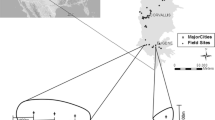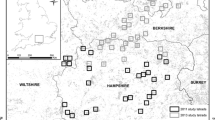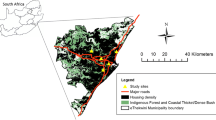Abstract
The influences of the landscape matrix (complex of habitats surrounding a study plot) and within-patch vegetation were studied in bird communities wintering in the piedmont of Georgia, USA. Variation at the landscape and within-patch levels was controlled to reduce the likelihood of confounding and spurious relationships. The landscape matrix within 500 m of each study plot was quantified from aerial photographs. Statistical models using landscape matrix and within-patch vegetation variables explained 73–84% of variation in bird abundance and diversity among sites with landscape matrix variables accounting for 30–90% of the variation. Variation in bird species richness and diversity was explained solely by landscape variables. Models for individual species such as Carolina Wrens (Thyrothorus ludovicianus) and Rufous-sided Towhees (Pipilo erythrophthalmus) had r2 > 0.80, with the landscape matrix variables accounting for the majority of this variation. However, other species like Northern Cardinals (Cardinalis cardinalis) and White-throated Sparrows (Zonotrichia albicollis) were most strongly influenced by within-plot vegetation. The landscape influence extended beyond habitats immediately adjacent to the study plots as indicated by significant variables describing variation in more distant habitat patches. These analyses illustrate a technique for comparing the strength of within-patch versus landscape influences and measuring the spatial extent of the landscape influence in fine-grained landscapes.
Report No. 3955, Environmental Sciences Division, Oak Ridge National Laboratory.
Similar content being viewed by others
References
Addicott, J.F., Aho, J.M., Antolin, M.R., Padilla, D.K., Richardson, J.S. and Soluk, D.A. 1987. Ecological neighborhoods: scaling environmental patterns. Oikos 49: 340–346.
Askins, R.A. and Philbrick, M.J. 1987. Effect of changes in regional forest abundance on the decline and recovery of a forest bird community. Wilson Bull. 99: 7–21.
Austin, O.L. 1968. Life histories of North American cardinals, grosbeaks, buntings, towhees, finches, sparrows, and allies. U.S. National Museum Bulletin 237.
Bach, C.E. 1988. Effects of host plant patch size on herbivore density: underlying mechanisms. Ecology 69: 1103–1117.
Blake, J.G. and Karr, J.R. 1987. Breeding birds of isolated woodlots: area and habitat relationships. Ecology 68: 1724–1734.
Butcher, G.S., Niering, W.A., Barry, W.J. and Goodwin, R.H. 1981. Equilibrium biogeography and the size of nature preserves: an avian case study. Oecologia 49: 29–37.
CERL. 1989. GRASS-GRID, version 3.1. U.S. Army Corps of Engineers. Construction Engineering and Research Laboratory.
Dunning, J.B. Jr., Danielson, B.J. and Pulliam, H.R. 1991. Processes that affect populations at the level of the landscape. Oikos (in review).
Forman, R.T.T. and Godron, M. 1986. Landscape ecology. Wiley and Sons, New York.
Freemark, K.E. and Merriam, H.G. 1986. Importance of area and habitat heterogeneity to bird assemblages in temperate forest fragments. Biol. Conserv. 36: 115–141.
Gardner, R.H., O'Neill, R.V., Turner, M.G. and Dale, V.H. 1989. Quantifying scale-dependent effects of animal movement with simple percolation models. Landsc. Ecol. 3: 217–227.
Hamel, P.B., Legrand, H.E., Lennartz, M.R. and Gauthreaux, S.A. 1982. Bird habitat relationships on southeastern forest lands. U.S. Forest Service General Technical Report SE-22. 417 pp.
Hurlbert, S.H. 1984. Pseudoreplication and the design of ecological experiments. Ecol. Monogr. 54: 187–211.
Johnson, R.A. and Wichern, D.W. 1988. Applied multivariate statistical analysis, 2nd ed. Prentice Hall, Englewood Cliffs, New Jersey.
Kendeigh, S.C. 1944. Measurement of bird populations. Ecol. Monogr. 14: 67–106.
Kroodsma, R.L. 1982. Bird community ecology on power-line corridors in east Tennessee. Biol. Conserv. 23: 79–94.
Lima, S.L., Wiebe, K.L. and Dill, L.M. 1987. Protective cover and the use of space by finches: is closer better? Oikos 50: 225–230.
Mills, G.S., Dunning, J.B. Jr. and Bates, J.M. 1991. The relationship between breeding bird density and vegetation volume. Wilson Bull. 103: 468–479.
Morgan, K.A. and Gates, J.E. 1982. Bird population patterns in forest edge and strip vegetation at Remington Farms, Maryland. J. Wildl. Manage. 46: 933–944.
O'Neill, R.V., Milne, B.T., Turner, M.G. and Gardner, R.H. 1988. Resource utilization scales and landscape pattern. Landsc. Ecol. 2: 63–69.
Pearson, S.M. 1991a. Food patches and the spacing of individual foragers. Auk 108: 355–362.
Pearson, S.M. 1991b. Influence of the surrounding landscape on wintering bird communities of old field habitats. Ph.D. dissertation. University of Georgia, Athens, Georgia, U.S.A.
Pulliam, H.R. and Danielson, B.J. 1991. Sources, sinks and habitat selection: a landscape perspective on population dynamics. Am. Nat. 137: S50-S66.
Pulliam, H.R. and Enders, F.A. 1971. The feeding ecology of five sympatric finch species. Ecology 52: 557–566.
Pulliam, H.R. and Mills, G.S. 1977. The use of space by wintering sparrows. Ecology 58: 1393–1399.
Quay, T.L. 1947. Winter birds of upland plant communities. Auk 64: 382–388.
Radford, A.E., Ahles, H.E. and Bell, C.R. 1968. Manual of the vascular flora of the Carolinas. The University of North Carolina Press, Chapel Hill.
Raivio, S. and Haila, Y. 1990. Bird assemblages in silvicultural habitat mosaics in southern Finland during the breeding season. Ornis Fennica 67: 73–83.
SAS. 1987. SAS, version 6.03. SAS Institute Inc., Cary, NC 27512–8000 U.S.A.
Schneider, K.J. 1984. Dominance, predation and optimal foraging in white-throated sparrow flocks. Ecology 65: 1820–1827.
Shannon, C.E. and Weaver, W. 1948. The mathematical theory of communication. Univ. of Illinois Press, Urbana.
Sokal, R.R. and Rohlf, F.J. 1981. Biometry, 2nd ed. W.H. Freeman and Company, New York.
Strong, T.R. and Bock, C.E. 1990. Bird species distribution patterns in riparian habitats in southeastern Arizona. Condor 92: 866–885.
Temple, S.A. and Cary, J.R. 1988. Modeling dynamics of habitat-interior bird populations in fragmented landscapes. Conserv. Biol. 4: 340–347.
Watts, B.D. 1990. Cover use and predator-related mortality in song and savannah sparrows. Auk 107: 775–778.
Watts, B.D. 1991. Segregation of an old field sparrow community along a cover gradient: effects of cover-dependency on spatial co-occurrence. Submitted.
Wiens, J.A. 1989. Spatial scaling in ecology. Func. Ecol. 3: 385–397.
Wiens, J.A. and Milne, B.T. 1989. Scaling of ‘landscapes’ in landscape ecology, or, landscape ecology from a beetle's perspective. Landsc. Ecol. 3: 87–96.
Wilcove, D.S., McLellan, C.H. and Dobson, A.P. 1986. Habitat fragmentation in the temperate zone. In Conservation Biology: the science of scarcity and diversity. pp. 237–256. Edited by M.E. Soule. Sinauer Associates, Inc., Sunderland, Massachusetts.
Author information
Authors and Affiliations
Additional information
This research received funding from the Ecological Research Division, Office of Health and Environmental Research, U.S. Department of Energy, under Contract No. DE-AC05-84OR21400 with Martin Marietta Energy Systems, Inc.
Rights and permissions
About this article
Cite this article
Pearson, S.M. The spatial extent and relative influence of landscape-level factors on wintering bird populations. Landscape Ecol 8, 3–18 (1993). https://doi.org/10.1007/BF00129863
Issue Date:
DOI: https://doi.org/10.1007/BF00129863




